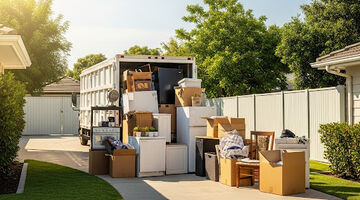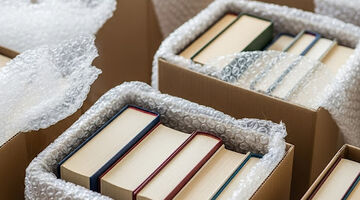Proper kitchen packing is crucial in order to prevent damage, and save yourself money and stress. It takes time and effort to pack up a kitchen correctly (if you want to avoid shattered glasses, broken dishes and food spilled inside of the moving boxes). That is why we always recommend not rushing when packing kitchen items and following these useful tips.
Prepare an Essentials Box
Before packing your kitchen, you should set aside the essentials you‘d be needing right before and after you move. It’s better to pack some kitchen items like forks, knives, dishes, and plates last, so make sure you have an essentials box with items for each member of the family.
Important Tip: Don’t forget to keep some kitchen appliances handy as well, these can include a dish towel, soap cleaner, and a sponge.
Gather your materials
Prepare some packing materials like packing paper, tape, kitchen moving boxes of all sizes, plastic or bubble wrap, cushioning materials to fill in all the spaces, markers to label the items. You’ll probably need more packing supplies to pack than you think, so it’s a good idea to gather as much packing materials as you can, especially if you don’t know how to pack fragile items for moving. If you need kitchen packing services in San Francisco feel free to contact professional movers from Got2Move.
Small Appliances
Use the original boxes to repack your appliances – since they offer the best protection, but in case you didn't save the original packing, look for sturdy small and medium kitchen packing boxes, plastic containers, and bubble wrap. You will also need tape, scissors, and markers to label each box.
Make sure to clean and dry the items before packing them for the move. Wrap the glass and fragile items with a layer of bubble wrap, and use a double layer for the metal and plastic parts of the appliance, then with tape.
Put a layer of packing paper, a sheet, or a towel on the bottom of the box to add more protection to appliances. Make sure to place the heaviest and largest parts of the appliance at the bottom of the box, and keep the smaller and fragile items on top.
Remember to fill all the empty spaces with cushioning material to avoid damage during the transportation of your kitchen appliances. Before closing the lids of the boxes, place a layer of packing paper or bubble wrap on top. Then close the boxes, seal them with tape, and label each box with the name of the appliance that is inside.

Dinnerware
When packing kitchen dishes, glasses, plates, knives you need to place two layers of cushioning material like a heavy towel or a folded bed sheet on the bottom of a medium-sized box. Wrap each piece of dinnerware with a piece of packing paper and start stacking them one by one inside of the box. For better protection, add a layer of packing material in between every three dishes.
The best way to pack dishes for moving or protect other fragile kitchen items – such as ceramic or porcelain cups and wine glasses – is to wrap each piece with bubble wrap (preferably) or contact professional packers in Los Angeles. But if you don't want to spend money on extra supplies, you can use other protective materials that you already have in your home like towels, fabric napkins, or even pieces of clothes, including tank tops and T-shirts.

Glasses and Stemware
- Cover each piece with bubble wrap and then use two layers of packing paper to cover the object. Do the same with your glassware.
- If you are not using sectioned boxes to pack your china, crystal glassware, cups or stemware, make sure to put plenty of crushed paper or bubble wrap on the bottom of each box for extra protection. Then use cushioning materials to fill in all the spaces – after packing the items inside of the box. You can also add towels and other linens to fill in all the gaps, so your items won't move and bump against each other during transport.
- Make sure to put the heaviest and largest objects at the bottom of the box and keep the smaller and fragile kitchen items on top.
- Before closing the lids of the boxes, place a layer of packing paper or bubble wrap on top. Then close the boxes and seal them with tape.
- Label the box with its contents and write: “fragile”.
- In case you prefer to use pre-sectioned boxes to pack your cups, stemware, and crystal glasses remember to wrap each piece individually with two layers of packing paper and add a protective layer of newspaper. Place each glass or cup upside down into the divisions or compartments of the box (make sure the handles face the same direction).

Pots and Pans
There is an efficient way for packing pots and pans for moving. Select some pots and pans that can be nested inside each other, then take the largest pot or pan and place a piece of protective material (such as towels) over the opening. Place a smaller pot inside of the first one, and push down the packing paper or linen. Continue packing pots and pans until you have a few together, wrap the whole bundle with a large piece of packing paper or a linen-like a big towel.
Wrap the glass lids with packing material or towels, and place them on the sides or top of the nested pots.
Flatware and Serving Utensils
Use packing paper to wrap kitchen utensils and tools, and then tuck the items into the boxes that you already packed, but there's still space inside of them. This a great tip to maximize the use of space and save on moving boxes.
Finally, remember that you can also place other objects like cooking sheets or cutting boards on the bottom of the boxes, and along the sides.
Important Tip: If you store your silverware and flatware inside of a decorative box, a chest, or another container, make sure to add cushioning (crumpled paper or linens) inside to prevent that the items bump against each other while being transported. Then cover the container with a large towel to protect it from scratches or dents.

Food Items
- Sort out the food that you have in your pantry.
- Toss out anything past the expiration date.
- Use a container or a basket to place the food that you want to donate to a food pantry or a shelter.
- Use tape, plastic wrap, or plastic sandwich bags to close the lids of the food that you want to take with you to your new kitchen.
- If you want to transport paper bags of sugar, pancake mix, or flour, make sure they are sealed shut and then pack each bag inside of a plastic grocery bag.
 Same-Day Junk Removal: Declutter Your Space
Same-Day Junk Removal: Declutter Your Space
 Packing Tips for Fragile Items
Packing Tips for Fragile Items
 How to Pack Books for Moving
How to Pack Books for Moving
 Best neighbourhoods in San Francisco
Best neighbourhoods in San Francisco
 California Car Registration and California Driver License
California Car Registration and California Driver License
 How Much Do Movers Cost In 2025
How Much Do Movers Cost In 2025




